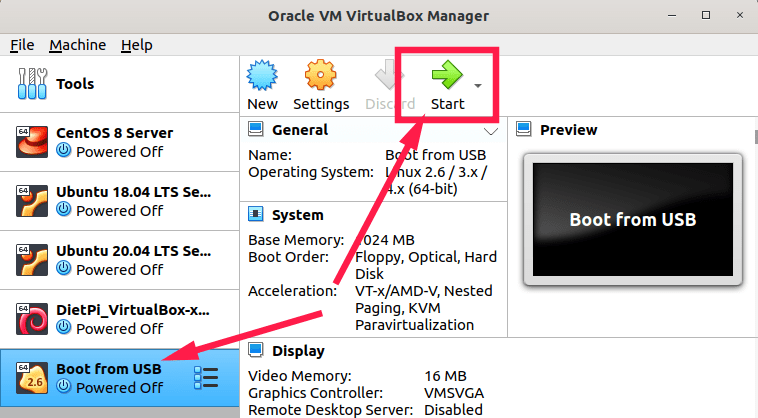

- #VIRTUALBOX BOOT FROM USB INSTALL#
- #VIRTUALBOX BOOT FROM USB FULL#
- #VIRTUALBOX BOOT FROM USB SOFTWARE#
- #VIRTUALBOX BOOT FROM USB ISO#
Popular choices for newcomers include Ubuntu, Mint and PCLinuxOS. Finding the "right" distro for you can only be done though experience but there are plenty of resources online to help you figure it out. For a new user jumping into the world of Linux-based operating systems the amount of options available can be overwhelming. There's no single right answer to that question. Which Linux distribution should I install? You can run YUMI's boot drive creator again to add More ISOs/distributions to your drive as needed and they'll all show up in this menu during boot. After choosing your USB drive you should see the YUMI boot menu where you can pick the desired Linux distribution in Live mode. To boot into Linux just plug the USB drive into the host computer, reboot, and press the required key during this process to enter the Boot Menu (usually F10).
#VIRTUALBOX BOOT FROM USB ISO#
Choose the source ISO file of the Linux distribution you downloaded. Select the Linux distribution you'll be installing from the list.
#VIRTUALBOX BOOT FROM USB INSTALL#
This is the successor to our MultibootISO and can be used to install more than one distribution to run from your USB. There are a few different tools for creating bootable USB drives around the web but one I'm particularly fond of is YUMI - short for Your Universal Multiboot Installer. If you'd rather load Linux without going through Windows first this is the way to go.
#VIRTUALBOX BOOT FROM USB FULL#
Running Virtualize ThisKey.exe will launch your Linux distribution in Windows (inside VirtualBox), whereas VirtualBox.exe opens the full VirtualBox interface. Once the process is finished, open your USB key in Windows Explorer and you should see a folder called VirtualBox containing two executable files: Virtualize ThisKey.exe and VirtualBox.exe. You will need and internet connection to complete the process - mainly to download VirtualBox if you don't have it installed. Leave the third box checked, the other two are up to you and self-explanatory. Select the USB drive where you want Linux installed.


Perhaps you just want to do something real quick without rebooting, or want to be able to hide the virtualized Linux instance. This option will come in handy if you want to run a Live Linux environment but need to retain access to Windows.

Running Linux from a USB drive in Windows This quick guide details both methods in a few easy steps.
#VIRTUALBOX BOOT FROM USB SOFTWARE#
There are basically two options when it comes to running Linux from a USB drive: from within Windows using virtualization software such as VirtualBox, or creating a boot disk. There are a number of uses to this, from simply test driving Linux to troubleshooting a Windows PC, or work on the go from someone else's computer but running your own OS securely with all your personal files and settings. Since nothing is written to the host computer's local storage, when you're done all you need to do is remove the media, reboot, and everything will be exactly as it was. Live Linux environments work just like a typical operating system but run entirely from a CD or USB stick - the latter being the most common choice these days.


 0 kommentar(er)
0 kommentar(er)
